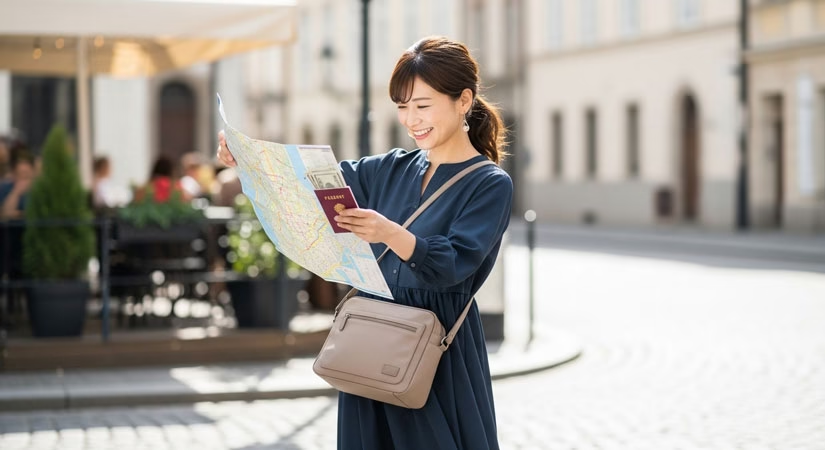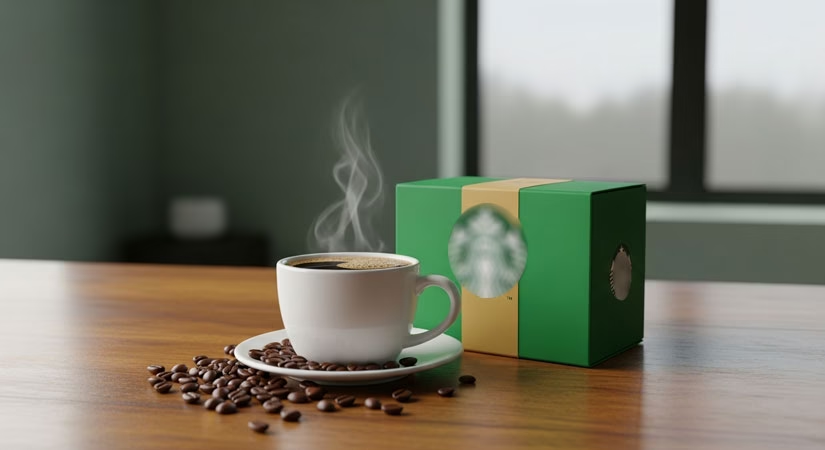ねぇ、広島に「世界で最も美しい美術館」に選ばれた場所があるのを知っていますか?
「美術館って、ちょっと静かで堅苦しいイメージ…」なんて思っている方にこそ、ぜひ訪れてほしいのが、今回ご紹介する「下瀬美術館」なんです。
瀬戸内海のキラキラした海辺にたたずむこの美術館は、これまでのアート施設の常識をくつがえす、驚きと感動に満ちた場所。
2023年春のオープン以来、またたく間に世界中から注目を集め、アートファンはもちろん、建築好きや旅行好きの心をも鷲掴みにしています。
この記事では、そんな下瀬美術館が「なぜ世界一美しいと称されるのか」という理由から、建築の秘密、コレクションの魅力、そしてカフェやアクセス方法まで、皆さんが知りたい情報を余すところなくお届けしますね。
この記事を読み終える頃には、きっと次の休日の計画を立て始めているはずですよ!

下瀬美術館の魅力を音声で説明いたします。下のスタートボタンでお聴きください。
はじめに:世界が認めた「最も美しい美術館」下瀬美術館とは?
そもそも、なぜ「世界一美しい」なんて言われているの?って気になりますよね。
実はこの下瀬美術館、2023年12月に、ユネスコが主催する建築の賞「プリ・ベルサイユ(Prix Versailles)」の「美術館・博物館部門」で、なんと世界一の称号である「ワールドタイトル」を受賞したんです!
この賞、建築界ではとっても権威があって、世界中の名だたる美術館の中から選ばれたと聞けば、そのすごさが伝わりますよね。まさに建築界のアカデミー賞のようなもの。
評価されたのは、単に建物が美しいというだけではありません。瀬戸内海の穏やかな自然環境と見事に調和し、訪れる人に特別な体験を与えてくれる空間づくりが高く評価された結果なんです。
キラキラと光を反射する水盤に、カラフルな展示室が浮かんでいる様子は、まるで宝石箱のよう。そんな唯一無二の光景が、ここ広島県大竹市であなたを待っています。
建築家・坂茂氏が手がけた独創的な建築
この美しい美術館を設計したのは、世界的に有名な建築家の坂茂(ばん しげる)さん。
皆さんも一度は「紙の建築」という言葉を耳にしたことがあるかもしれません。坂さんは、木材だけでなく、紙管(しかん)というリサイクル可能な紙の筒を建築材料に使うことで知られています。
災害が起きたときには、被災地に紙でできた仮設住宅や間仕切りを届けるなど、社会に貢献する活動でも世界的に尊敬されている建築家さんなんですよ。
そんな坂さんが下瀬美術館で掲げたコンセプトは「アートの中でアートを観る」。
一体どういうことなのでしょうか?その秘密を一つずつ見ていきましょう。
水盤に浮かぶカラフルな「可動展示室」
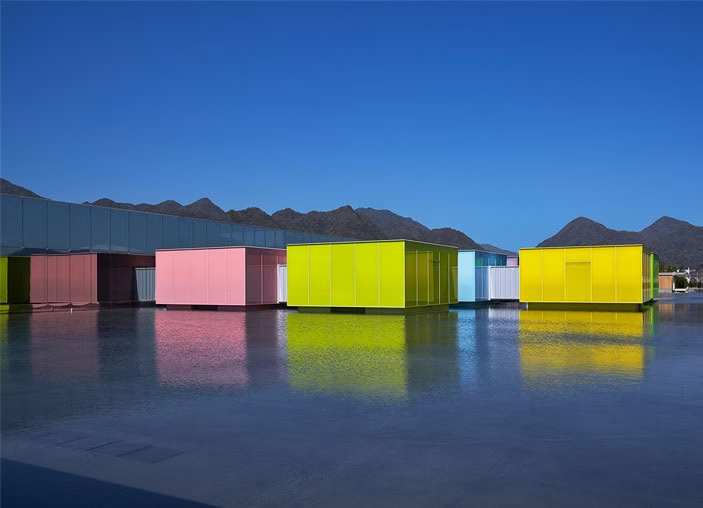
下瀬美術館を訪れた人が、まず最初に心を奪われるのが、エントランスの先に広がる大きな水盤と、そこに浮かぶ8つのカラフルな箱。
これが、この美術館の最大の特徴である「可動展示室」です。
「え、建物が水に浮かんでるの?しかも動くの!?」と驚きますよね。
そうなんです。この展示室は、なんと水の浮力を使って、水盤の上を自由に移動させることができるという、世界でも類を見ない画期的な構造になっています。
まるで瀬戸内海に浮かぶ島々のように見えるこの展示室は、実際に船を造る造船所で造られたのだとか。壁の色も一つひとつ違っていて、外から眺めているだけでもワクワクしてきます。
それぞれの展示室へは、水盤に架けられた橋を渡ってアプローチします。まるで島から島へと冒険するような感覚で、アート鑑賞を楽しめるんですよ。
口コミでも、
「本当に展示室が浮いていて感動した!」
「未来の美術館みたいで、歩いているだけで楽しかった」
という声がたくさん見られました。これはもう、体験してみるしかありませんね!
ミラーガラスが映し出す瀬戸内海の絶景
展示室の壁面には、鏡のように景色を映し出すミラーガラスが効果的に使われています。
このミラーガラスが、本当にすごいんです。
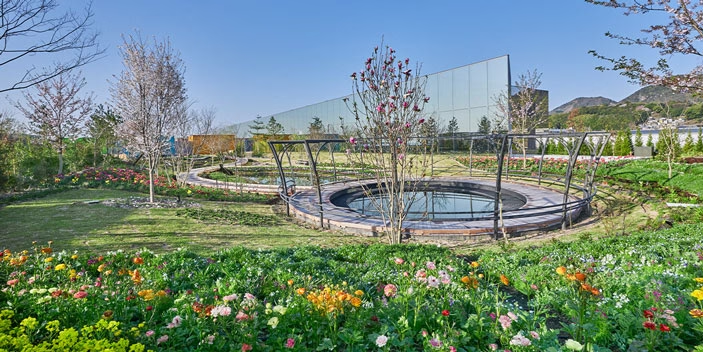
目の前に広がる瀬戸内海の空や海、そして対岸の工場地帯のシルエットを映し込み、時間や天気によって全く違う表情を見せてくれます。
晴れた日には青空と白い雲が映り込み、建物と自然の境界線がなくなるような不思議な感覚に。
夕暮れ時には、空のグラデーションがガラスに映って、あたり一面がロマンチックな雰囲気に包まれます。
どこを切り取っても絵になるので、カメラのシャッターを切る手が止まらなくなってしまうかも。特に、水盤に映る展示室と、ミラーガラスに映る空が一体化した写真は、SNSでも「映える!」と大人気です。
木のぬくもりを感じるエントランスホール
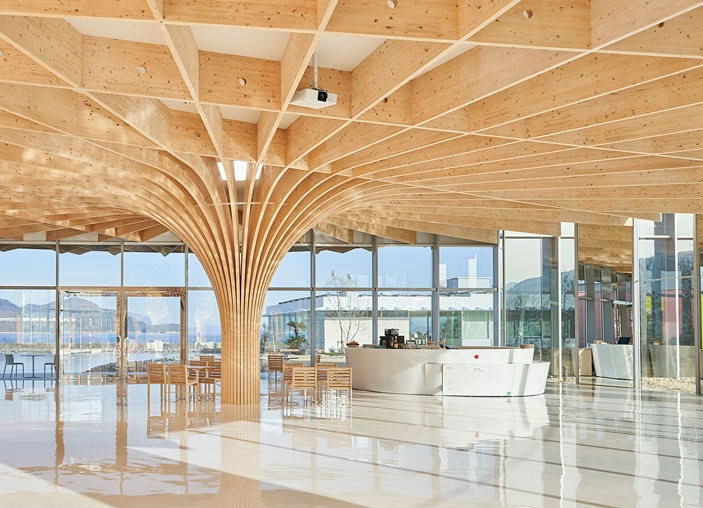
カラフルで未来的な展示室とは対照的に、エントランスやカフェが入るメインの建物は、木のぬくもりを大切にした、とても心地よい空間になっています。
高い天井を支えているのは、集成材を使った美しい木の柱と梁。開放感がありながらも、どこか落ち着く雰囲気は、さすが坂茂さんの建築です。
そして、ここでも坂さんならではの遊び心を発見できます。
エントランスホールに置かれているベンチをよく見てみてください。なんと、これも坂さんが得意とする「紙管」でできているんです!
「紙でできたベンチって、座っても大丈夫なの?」と心配になるかもしれませんが、これが驚くほど頑丈。ぜひ実際に座って、その感触を確かめてみてくださいね。
下瀬美術館のコレクションと見どころ
「建築がすごいのはわかったけど、どんな作品が観られるの?」というのも、気になるところですよね。
下瀬美術館のコレクションは、創設者である下瀬家が三代にわたって収集した、約500点もの作品で構成されています。そのジャンルはとても幅広く、誰が訪れてもきっとお気に入りの作品が見つかるはずです。
下瀬コレクションの魅力
コレクションの中心となるのは、日本の近代洋画や、フランスで活躍したエコール・ド・パリの画家たちの作品。
例えば、岸田劉生の有名な「麗子像」を思わせるような肖像画や、マティス、シャガールといった巨匠たちの作品にも出会えます。
さらに、京都画壇の作品や、人形、ガラス工芸品など、本当に多彩なラインナップ。一つの展示室で西洋の絵画を観たかと思えば、隣の展示室では日本の工芸品の繊細な美しさに触れる、といった楽しみ方ができるのも、この美術館ならではの魅力です。
西洋から見た東洋:マイセン磁器の世界
コレクションの中でも特に注目したいのが、ヨーロッパ最古の硬質磁器窯「マイセン」の作品たちです。
驚くことに、これらの美しい磁器は、日本の「柿右衛門」様式に強い影響を受けて作られたものなのだとか。
17世紀、日本の有田焼がヨーロッパに渡り、その美しさが王侯貴族たちを魅了しました。当時のヨーロッパの人々が、遠い東洋の国に思いを馳せながら、そのデザインを模倣し、独自の解釈で作り上げたのが、これらのマイセン磁器なんです。
日本人が作った器に憧れて、ヨーロッパの職人たちが作った作品が、時を経てまた日本に戻ってきて、この広島の地で展示されている…なんだか、とても壮大な物語を感じませんか?
エミール・ガレの庭:作品と自然が溶け合う場所

アール・ヌーヴォーを代表するフランスの芸術家、エミール・ガレ。彼の作品は、植物や昆虫といった自然のモチーフを生き生きと表現しているのが特徴です。
下瀬美術館には、彼の作品に描かれている草花を実際に植えた「エミール・ガレの庭」があります。
ガラスのランプに描かれたアザミや、花瓶にデザインされたユリの花を、作品鑑賞の後に実際のお庭で探してみる。そんな素敵な体験ができるんです。
作品の世界観をより深く理解できるだけでなく、季節ごとに違う花が咲くので、訪れるたびに新しい発見がありそうですね。
望洋テラス:瀬戸内海を一望する絶景スポット
館内の見どころとして、絶対に外せないのが「望洋(ぼうよう)テラス」です。
その名の通り、瀬戸内海の多島美を心ゆくまで眺めることができる、最高のビュースポット。目の前には穏やかな海が広がり、宮島や阿多田島などを望むことができます。
| 時間帯 | 見どころ |
| 昼間 | キラキラと太陽の光を反射する海面と、青い空のコントラストが美しい。行き交う船を眺めながら、のんびり過ごすのに最適。 |
| 夕暮れ | 空と海がオレンジ色に染まる、息をのむほどロマンチックな時間。一日の中でも特に美しいマジックアワー。 |
| 夜 | 対岸にある大竹コンビナートの灯りがきらめき、幻想的な工場夜景が楽しめる。 |
このテラスは、美術館のチケットがなくても利用できるエリアにあるのも嬉しいポイント。ドライブの途中に、この景色を見るためだけに立ち寄る、なんていう贅沢な使い方もできちゃいます。
美術館を五感で楽しむ
下瀬美術館は、アートを「見る」だけの場所ではありません。美味しい食事や素敵なグッズなど、五感で楽しめる魅力がいっぱいです。
ミュージアムカフェ
エントランスホールに併設されたミュージアムカフェは、大きな窓から水盤を眺められる特等席。
歩き疲れたら、ここで一休みしませんか?
メニューには、地元の食材を使ったこだわりの品が並びます。
- 見た目も可愛いサンドイッチ
- 季節のフルーツを使ったケーキ
- 広島県産レモンを使った爽やかなドリンク
など、どれにしようか迷ってしまいそう。
口コミでは「景色がごちそう」「ケーキが本格的で美味しかった」といった声が多く、カフェを目当てに訪れる人もいるほど。アート鑑賞の余韻に浸りながら、ゆったりとした時間を過ごせます。
ミュージアムショップ
旅の思い出に、お土産選びは欠かせませんよね。
ミュージアムショップには、下瀬美術館でしか手に入らないオリジナルグッズがずらり。
- 坂茂さんがデザインしたスタイリッシュな文房具
- 所蔵作品をモチーフにしたポストカードやクリアファイル
- センスのいいアート関連書籍
など、アート好きの心をくすぐるアイテムがたくさん。自分用にはもちろん、大切な人へのプレゼントにもぴったりなものが見つかるはずです。
フレンチレストラン「Simose French Restaurant」
特別な日や、ちょっと贅沢なランチを楽しみたい方には、敷地内にあるフレンチレストラン「Simose French Restaurant」がおすすめです。
こちらも美術館と同じく、水盤を望む最高のロケーション。
まるで水の上に浮かんでいるかのような空間で、地元の旬の食材をふんだんに使った、本格的なフランス料理を堪能できます。
記念日ディナーや、自分へのご褒美ランチに利用すれば、忘れられない思い出になること間違いなし。人気なので、訪れる際は事前に予約をしておくと安心ですよ。
下瀬美術館へのアクセス・基本情報
さあ、これで行きたくてたまらなくなった皆さんのために、具体的なアクセス情報や基本情報をまとめました。お出かけ前にしっかりチェックしてくださいね。
基本情報
| 項目 | 内容 |
| 住所 | 〒739-0622 広島県大竹市晴海2丁目10-50 |
| 電話番号 | 0827-59-0016 |
| 開館時間 | 9:30~17:00(入館は16:30まで) |
| 休館日 | 月曜日(祝日の場合は開館、翌平日休館)、年末年始 |
| 入館料 | 一般:1,800円、高大生:900円、中学生以下:無料 |
| 公式サイト | https://simose-museum.jp/ |
※開館時間や休館日は変更になる場合があるので、お出かけ前には公式サイトで最新情報をご確認ください。
アクセス方法
都心部からは少し離れているので、アクセス方法は事前に計画を立てておくのがおすすめです。
公共交通機関を利用する場合
- 新幹線で「JR広島駅」または「JR新岩国駅」へ
- JR山陽本線に乗り換え、「JR大竹駅」で下車
- 大竹駅から
- タクシーで約8分
- こいこいバス(循環バス)「晴海臨海公園」行きに乗車し約10分、「晴海臨海公園」バス停下車すぐ
車を利用する場合
山陽自動車道の「大竹IC」または「岩国IC」から約15分です。
ここで一つ、とても大事な注意点があります!
カーナビで「下瀬美術館」と検索すると、正しく案内されないことがあるようです。
カーナビを設定する際は、目的地を「晴海(はるみ)臨海公園」に設定してください。
美術館はこの公園のすぐ隣にあります。これを知っておくだけで、道に迷う心配がなくなるので、ぜひ覚えておいてくださいね。駐車場も完備されています(無料)。
周辺のおすすめ観光スポット
せっかく大竹市まで来たのなら、周辺の観光も楽しみたいですよね。下瀬美術館と合わせて訪れたい、おすすめスポットを2つご紹介します。
岩国・錦帯橋
下瀬美術館から車で約20分ほどの場所にあるのが、山口県岩国市の「錦帯橋(きんたいきょう)」です。
日本三名橋の一つにも数えられる、5連のアーチが美しい木造橋。寸分の狂いもなく組まれた木組みの技術は、まさに芸術品です。
橋を渡るだけでなく、河原から眺めたり、遊覧船に乗って下から見上げたりと、色々な楽しみ方ができます。春は桜、夏は鵜飼い、秋は紅葉、冬は雪景色と、四季折々の風景が美しいのも魅力です。
宮島・嚴島神社
もう少し足を延ばせるなら、世界遺産「嚴島神社」のある宮島まで行くのも素敵なプランです。
下瀬美術館からは、車とフェリーを乗り継いで約1時間ほど。
海の中に立つ朱塗りの大鳥居は、あまりにも有名ですよね。潮が満ちてくると、まるで社殿全体が海に浮かんでいるかのような幻想的な光景が広がります。
かわいい鹿たちとのふれあいや、表参道商店街での食べ歩きも楽しみの一つ。焼き牡蠣やもみじ饅頭など、美味しい誘惑がいっぱいです。
まとめ
今回は、広島にある「世界一美しい美術館」、下瀬美術館の魅力をご紹介しましたが、いかがでしたか?
- 世界が認めた、瀬戸内海の自然と一体化した建築
- 水に浮かぶカラフルな「可動展示室」という驚きの体験
- ジャンル豊かなコレクションと、アートの新しい見せ方
- 絶景テラスや美味しいカフェなど、五感で楽しめる仕掛け
下瀬美術館は、ただ美しいだけじゃない、訪れる人一人ひとりの心に深く刻まれる、新しい時代のアートスポットでした。
アートに詳しい人も、そうでない人も、きっと誰もが新鮮な感動と癒やしをもらえるはず。
次の休日は、この世界に誇る美しい美術館で、日常を忘れる特別な一日を過ごしてみませんか?
[Hiroshima] Like a Jewelry Box on Water! A Complete Guide to the “World’s Most Beautiful Museum,” the Shimose Art Museum
Hey, did you know there’s a place in Hiroshima that was named the “most beautiful museum in the world”?
If you’re someone who thinks, “Museums are a bit too quiet and formal for me…,” then the “Shimose Art Museum,” which we’re introducing today, is a place you absolutely have to visit.
Nestled on the shimmering seaside of the Seto Inland Sea, this museum is a place full of wonder and excitement that redefines the conventional art facility.
Since its opening in the spring of 2023, it has quickly garnered attention from all over the world, capturing the hearts of not only art fans but also architecture enthusiasts and travel lovers.
In this article, we’ll cover everything you want to know—from the reasons why the Shimose Art Museum is called “the most beautiful in the world,” to the secrets of its architecture, the charm of its collection, and even its café and access information.
By the time you finish reading this, you’ll surely be starting to plan your next holiday!
Introduction: What is the Shimose Art Museum, the World-Renowned “Most Beautiful Museum”?
First of all, you’re probably wondering why it’s called “the most beautiful in the world,” right?
Well, in December 2023, the Shimose Art Museum was awarded the “World Title” in the “Museums” category of the Prix Versailles, an architectural award organized by UNESCO!
This award is incredibly prestigious in the world of architecture. When you hear that it was chosen from among numerous famous museums worldwide, you can understand just how amazing that is. It’s truly like the Academy Awards of the architecture world.
It wasn’t just the beauty of the building that was praised. The museum was highly acclaimed for its masterful harmony with the serene natural environment of the Seto Inland Sea and for creating a space that offers visitors a special experience.
The sight of the colorful exhibition rooms floating on the water basin, which sparkles as it reflects the light, is just like a jewelry box. This one-of-a-kind scene awaits you here in Otake City, Hiroshima Prefecture.
The Innovative Architecture of Shigeru Ban
This beautiful museum was designed by the world-renowned architect, Shigeru Ban.
You may have heard the term “paper architecture” before. Mr. Ban is known for using not only wood but also recyclable paper tubes as building materials.
He is also respected globally for his social contributions, such as providing temporary housing and partitions made of paper to disaster-stricken areas.
The concept Mr. Ban established for the Shimose Art Museum is “Viewing Art Within Art.”
What exactly does that mean? Let’s explore the secrets one by one.
The Colorful “Movable Exhibition Rooms” Floating on a Water Basin
The first thing that captivates visitors to the Shimose Art Museum is the large water basin that spreads out beyond the entrance, and the eight colorful boxes floating upon it.
This is the museum’s most prominent feature: the “Movable Exhibition Rooms.”
“Wait, the building is floating on water? And it moves!?” You’d be surprised, right?
That’s right. These exhibition rooms use the buoyancy of water, allowing them to be moved freely across the basin—an innovative structure unlike any other in the world.
These rooms, which look like islands floating in the Seto Inland Sea, were actually built at a shipyard where ships are made. The color of each wall is different, making it exciting just to look at them from the outside.
You approach each exhibition room by crossing a bridge over the water. You can enjoy viewing art as if you were adventuring from one island to another.
Online reviews are full of comments like:
“I was so moved to see the exhibition rooms actually floating!”
“It felt like a museum from the future; just walking around was fun.”
This is something you just have to experience for yourself!
The Breathtaking View of the Seto Inland Sea Reflected in Mirror Glass
The walls of the exhibition rooms effectively use mirror glass that reflects the scenery like a mirror.
And this mirror glass is truly incredible.
It reflects the sky and sea of the Seto Inland Sea spread out before you, as well as the silhouette of the industrial zone on the opposite shore, showing completely different expressions depending on the time and weather.
On a sunny day, the blue sky and white clouds are reflected, creating a magical feeling where the boundary between the building and nature disappears.
At dusk, the gradient of the sky is reflected on the glass, wrapping the entire area in a romantic atmosphere.
Every angle is picturesque, so you might find you can’t stop taking photos. The pictures of the exhibition rooms reflected in the water basin combined with the sky reflected in the mirror glass are especially popular on social media for being so “Insta-worthy!”
The Entrance Hall with the Warmth of Wood
In contrast to the colorful and futuristic exhibition rooms, the main building, which houses the entrance and cafe, is a very comfortable space that values the warmth of wood.
Supporting the high ceiling are beautiful pillars and beams made of laminated timber. While it feels open, there’s also a calming atmosphere—a signature of Shigeru Ban’s architecture.
And here, too, you can discover Mr. Ban’s unique sense of playfulness.
Take a close look at the benches in the entrance hall. Amazingly, they are also made from the “paper tubes” that Mr. Ban is famous for!
You might worry, “A bench made of paper? Is it really okay to sit on?” But it’s surprisingly sturdy. Be sure to sit down and feel it for yourself.
The Shimose Art Museum’s Collection and Highlights
“The architecture is amazing, but what kind of art can I see?” That’s another thing you’re probably curious about.
The Shimose Art Museum’s collection consists of about 500 works collected by the founding Shimose family over three generations. The genre is so wide-ranging that anyone who visits is sure to find a piece they love.
The Charm of the Shimose Collection
The core of the collection consists of modern Japanese Western-style paintings and works by artists of the École de Paris who were active in France.
For example, you can encounter portraits reminiscent of Ryusei Kishida’s famous “Reiko” series, as well as works by masters like Matisse and Chagall.
Furthermore, the lineup is truly diverse, including works from the Kyoto school of painting, dolls, and glass crafts. Being able to view Western paintings in one room and then experience the delicate beauty of Japanese crafts in the next is another unique charm of this museum.
The East as Seen from the West: The World of Meissen Porcelain
Among the collection, the works from “Meissen,” Europe’s oldest hard-paste porcelain manufactory, are particularly noteworthy.
Surprisingly, these beautiful porcelains were created under the strong influence of Japan’s “Kakiemon” style.
In the 17th century, Japanese Arita ware made its way to Europe, and its beauty fascinated kings and nobles. The people of Europe at the time, dreaming of a distant Eastern land, imitated its designs and created these Meissen porcelains with their own unique interpretations.
Works created by European craftsmen who admired Japanese pottery have, over time, returned to Japan to be displayed here in Hiroshima… Doesn’t it feel like a part of a grand story?
Émile Gallé’s Garden: Where Art and Nature Merge
Émile Gallé was a leading French artist of the Art Nouveau movement. His work is characterized by lively depictions of natural motifs such as plants and insects.
The Shimose Art Museum has an “Émile Gallé Garden,” where the flowers and plants depicted in his works are actually planted.
You can have the wonderful experience of looking for the thistles depicted on a glass lamp or the lilies designed on a vase in the actual garden after viewing the artworks.
Not only can you gain a deeper understanding of the world of his works, but different flowers bloom each season, so you’re likely to make new discoveries with every visit.
Bouyou Terrace: A Superb Viewing Spot Overlooking the Seto Inland Sea
As a must-see highlight within the museum, the “Bouyou Terrace” is absolutely unmissable.
As its name (“Ocean View”) suggests, it’s the ultimate viewing spot where you can gaze at the scenic beauty of the Seto Inland Sea’s many islands to your heart’s content. The calm sea spreads out before you, offering views of Miyajima, Atatajima, and more.
| Time of Day | Highlights |
| Daytime | The contrast between the sea surface sparkling in the sunlight and the blue sky is beautiful. Perfect for relaxing while watching the ships come and go. |
| Dusk | A breathtakingly romantic time when the sky and sea are dyed orange. The most beautiful magic hour of the day. |
| Night | The lights of the Otake Industrial Complex on the opposite shore twinkle, offering a fantastic view of the factory nightscape. |
A great bonus is that this terrace is in an area that can be accessed without a museum ticket. You could even make a luxurious stop just to see this view during a drive.
Enjoying the Museum with All Five Senses
The Shimose Art Museum isn’t just a place to “see” art. It’s full of attractions to be enjoyed with all five senses, including delicious food and wonderful goods.
Museum Café
The museum café, located next to the entrance hall, is a prime spot with a view of the water basin from its large windows.
Why not take a break here when you’re tired of walking?
The menu features special items made with local ingredients.
- Visually cute sandwiches
- Cakes made with seasonal fruits
- Refreshing drinks made with Hiroshima lemons
You’ll have a hard time choosing.
Many reviews say things like “The view is a feast for the eyes” and “The cake was authentic and delicious,” and some people even visit just for the café. You can spend a relaxing time here, soaking in the afterglow of your art appreciation.
Museum Shop
Choosing souvenirs is an essential part of any trip’s memories, isn’t it?
The museum shop is stocked with original goods that you can only buy at the Shimose Art Museum.
- Stylish stationery designed by Shigeru Ban
- Postcards and clear files featuring motifs from the collection
- Art-related books with great taste
There are plenty of items that will excite any art lover. You’re sure to find something perfect for yourself or as a gift for someone special.
French Restaurant “Simose French Restaurant”
For special occasions or when you want to enjoy a slightly luxurious lunch, the on-site “Simose French Restaurant” is highly recommended.
Like the museum, it boasts a prime location overlooking the water basin.
In a space that feels as if it’s floating on water, you can savor authentic French cuisine made with an abundance of local, seasonal ingredients.
Using it for an anniversary dinner or a reward-yourself lunch will surely create unforgettable memories. It’s popular, so it’s a good idea to make a reservation in advance.
Access & Basic Information for Shimose Art Museum
Now, for all of you who are dying to go, here is the specific access and basic information. Be sure to check it before you head out!
Basic Information
| Item | Details |
| Address | 2-10-50 Harumi, Otake City, Hiroshima 739-0622 |
| Phone | 0827-59-0016 |
| Hours | 9:30 AM – 5:00 PM (Last admission at 4:30 PM) |
| Closed | Mondays (or the next weekday if Monday is a holiday), New Year holidays |
| Admission | General: ¥1,800, High School/University Students: ¥900, Jr. High & under: Free |
| Official Site | https://simose-museum.jp/en/ |
※Hours and closed days are subject to change, so please check the official website for the latest information before your visit.
How to Get There
It’s a little far from urban centers, so it’s best to plan your access route in advance.
By Public Transportation
- Take the Shinkansen to “JR Hiroshima Station” or “JR Shin-Iwakuni Station.”
- Transfer to the JR Sanyo Main Line and get off at “JR Otake Station.”
- From Otake Station:
- Approx. 8 minutes by taxi.
- Take the “Koikoi Bus” (loop bus) bound for “Harumi Rinkai Park” for about 10 minutes and get off at the “Harumi Rinkai Park” bus stop, right next to the museum.
By Car
It’s about a 15-minute drive from the “Otake IC” or “Iwakuni IC” on the Sanyo Expressway.
And here is one very important tip!
Searching for “Shimose Art Museum” in a car navigation system may not provide the correct directions.
When setting your car navigation system, please set the destination to “Harumi Rinkai Park” (晴海臨海公園).
The museum is right next to this park. Just knowing this will save you from getting lost, so please keep it in mind. Parking is also available (free of charge).
Recommended Nearby Tourist Spots
Since you’ve come all the way to Otake City, you’ll probably want to enjoy some of the surrounding sights as well. Here are two recommended spots to visit in conjunction with the Shimose Art Museum.
Iwakuni・Kintai Bridge
About a 20-minute drive from the Shimose Art Museum is the “Kintai Bridge” in Iwakuni City, Yamaguchi Prefecture.
Counted as one of Japan’s three most famous bridges, it’s a beautiful wooden bridge with five connecting arches. The technique of its wooden framework, assembled without a single flaw, is truly a work of art.
You can enjoy it in various ways, not just by crossing it, but also by viewing it from the riverbank or looking up from a pleasure boat. Its beauty shines in every season, with cherry blossoms in spring, cormorant fishing in summer, autumn leaves in fall, and snowscapes in winter.
Miyajima・Itsukushima Shrine
If you can venture a little further, going to Miyajima, home of the World Heritage site “Itsukushima Shrine,” is also a wonderful plan.
It takes about an hour from the Shimose Art Museum by car and ferry.
The great vermilion torii gate standing in the sea is incredibly famous. When the tide comes in, the entire shrine complex looks as if it’s floating on the sea, creating a fantastical scene.
Interacting with the cute deer and strolling along the Omotesando shopping street for food are also part of the fun. There are plenty of delicious temptations, like grilled oysters and momiji manju.
Conclusion
So, how did you like our introduction to the charms of the “world’s most beautiful museum,” the Shimose Art Museum in Hiroshima?
- World-renowned architecture integrated with the nature of the Seto Inland Sea.
- The surprising experience of the colorful “Movable Exhibition Rooms” floating on water.
- A rich and varied collection and a new way of presenting art.
- Features to be enjoyed with all five senses, like the scenic terrace and delicious café.
The Shimose Art Museum is more than just beautiful; it’s a new era art spot that leaves a deep impression on the heart of every visitor.
Whether you’re an art expert or not, everyone is sure to find fresh inspiration and a sense of healing.
For your next day off, why not spend a special day forgetting the everyday at this world-class, beautiful museum?
